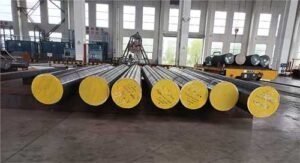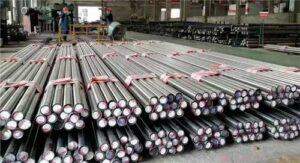In the realm of industrial applications where extreme heat and demanding conditions are the norm, materials with exceptional properties are crucial. Hot work tool steel stands out as a remarkable class of materials specially designed to excel in high-temperature environments. This comprehensive article explores the key properties that make hot work tool steel the material of choice for heat-intensive tasks across various industries.
1. Understanding Hot Work Tool Steel
1.1 What is Hot Work Tool Steel?
Hot work tool steel is a specialized category of steel engineered to maintain its mechanical properties, including hardness and strength, even when subjected to extreme temperatures. It is designed for applications that involve continuous exposure to heat, typically ranging from 600°C (1,112°F) to 1200°C (2,192°F).
1.2 Composition and Alloying Elements
The composition of hot work tool steel is meticulously crafted to enhance its performance in high-temperature environments. Common alloying elements include chromium, tungsten, molybdenum, and vanadium. These elements contribute to the steel’s heat resistance, hardness, and wear resistance.
1.3 Applications of Hot Work Tool Steel
Hot work tool steel finds wide-ranging applications in various industries, including die casting, forging, extrusion, high-temperature cutting tools, plastic molding, and aerospace and automotive manufacturing. Its versatility and exceptional properties make it a preferred choice for heat-intensive tasks.
2. Key Properties of Hot Work Tool Steel
Hot work tool steel boasts several essential properties that make it ideal for heat-intensive tasks:
2.1 High Heat Resistance
The primary advantage of hot work tool steel is its ability to withstand extreme temperatures without compromising its mechanical properties. It maintains its strength and hardness even at temperatures exceeding 1000°C (1832°F).
2.2 Superior Toughness
Hot work tool steel retains its toughness and impact resistance even when subjected to rapid temperature changes. This characteristic prevents brittleness and ensures the material can handle the dynamic nature of heat-intensive processes.
2.3 Exceptional Wear Resistance
In heat-intensive tasks, tools and components are often subjected to abrasive wear. Hot work tool steel’s exceptional wear resistance ensures long-lasting performance, reducing the need for frequent replacements and improving productivity.
2.4 Efficient Thermal Conductivity
Good thermal conductivity is essential for dissipating heat evenly across tools and components, preventing localized overheating. Hot work tool steel’s efficient thermal conductivity contributes to its durability in high-temperature environments.
2.5 Dimensional Stability
Maintaining precise dimensions is critical in many industrial applications. Hot work tool steel’s dimensional stability ensures that tools and components retain their shape and accuracy under thermal stress, resulting in consistent and reliable results.
3. Applications in Heat-Intensive Tasks
Hot work tool steel finds extensive use in various industries where heat-intensive tasks are common. Some prominent applications include:
3.1 Die Casting
Die casting dies made from hot work tool steel maintain their strength and durability even when subjected to extreme temperatures. This ensures the production of intricate and high-quality castings.
3.2 Forging
In the forging industry, hot work tool steel is indispensable for creating dies and tools that shape metals at elevated temperatures. Its toughness and wear resistance contribute to efficient and precise forging processes.
3.3 Extrusion
Extrusion processes, which involve forcing materials through a die at high temperatures, benefit from hot work tool steel’s durability and heat resistance. It enables the creation of heat-resistant dies for consistent and reliable extrusion.
3.4 High-Temperature Cutting Tools
Manufacturers use hot work tool steel for cutting tools that must endure extreme heat during machining processes. This extends tool life and ensures the maintenance of cutting precision.
3.5 Plastic Molding
Plastic molding applications, especially those involving thermoplastics, rely on hot work tool steel’s ability to withstand the heat generated during the molding process. This results in the production of consistent and high-quality plastic parts.
3.6 Aerospace and Automotive Industries
In the aerospace and automotive sectors, where components must withstand high temperatures during operation, hot work tool steel plays a vital role in maintaining the strength and integrity of critical parts.
4. FAQ: Addressing Common Questions
4.1 What distinguishes hot work tool steel from other steel types?
Hot work tool steel is specifically engineered to maintain its mechanical properties, including hardness and strength, at high temperatures. This sets it apart from standard steel grades and makes it suitable for heat-intensive tasks.
4.2 How does hot work tool steel maintain its properties at high temperatures?
Hot work tool steel’s ability to maintain its properties at high temperatures is attributed to its heat-resistant alloying elements, microstructural stability, and efficient thermal conductivity, which collectively ensure its integrity even in extreme heat.
4.3 Are there any limitations to using hot work tool steel in heat-intensive tasks?
While hot work tool steel excels in heat-intensive tasks, it may not be suitable for highly corrosive environments. Additionally, extreme temperatures at the upper end of its range may lead to some degradation over time.
4.4 Can hot work tool steel be customized for specific industrial needs?
Yes, hot work tool steel can be customized through adjustments in composition and heat treatment to meet the specific requirements of various industrial applications.
4.5 What are some real-world examples of hot work tool steel applications in heat-intensive tasks?
Real-world examples include die casting dies, forging tools, extrusion dies, high-temperature cutting tools, plastic molding components, and critical parts in aerospace and automotive industries, all of which rely on hot work tool steel’s exceptional properties in heat-intensive environments.

